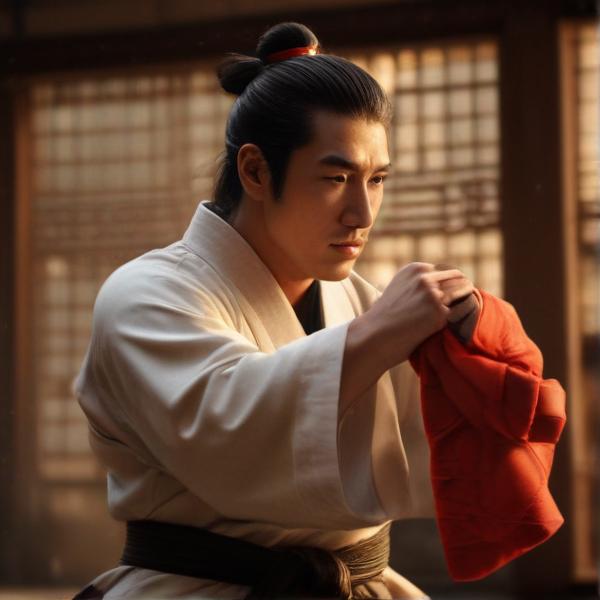基本信息 (Basic Information)
含义与用法 (Meanings & Usage)
中文核心释义 (Core Chinese Meaning): 拳头,用手握成的形状,比喻拳击等格斗动作,也指中国传统武术的一种套路。
英文核心释义 (Core English Meaning): fist; the shape made by clenching the hand; also refers to boxing or styles of martial arts.
象形意义 / 为何这么写 (Pictographic Meaning / Writing Rationale)
文言文释义 (Classical Chinese Meaning)
与现代意义相近,主要指拳头,或引申为拳术。Similar to modern meaning, mainly refers to 'fist,' or by extension, to martial arts techniques.
深入学习 (In-depth Study)
字源故事 (Origin Story)
字形演变 (Character Evolution)
常用词语和例句 (Common Words & Examples)
拳头 (fist)
他紧紧地握紧了拳头。
Eng: He clenched his fist tightly.
太极拳 (Tai Chi (a style of traditional Chinese martial arts))
很多公园里都有人在练太极拳。
Eng: Many people practice Tai Chi in parks.
拳击 (boxing (a combat sport))
拳击是一项激烈的运动。
Eng: Boxing is an intense sport.
相关成语 (Related Idioms)
手无寸铁,拳不离手
Meaning: Unarmed, yet always ready with one's own fists; to be skilled in fighting even without weapons
多语言翻译 (核心释义) (Translations (Core Meaning))
- French: poing
- German: Faust
- Spanish: puño
- Italian: pugno
- Portuguese: punho
- Russian: кулак
- Arabic: قبضة اليد
- Persian: مشت
- Dutch: vuist
- Polish: pięść
- Vietnamese: nắm đấm
- Ukrainian: кулак
视频学习资源 (Video Learning Resources)
通过以下链接在热门视频网站搜索 "拳" 的更多讲解:
Search for more explanations of "拳" on popular video sites:
- 在 Bilibili.com 搜索 "拳 字源 说文解字" (Search on Bilibili)
- 在 YouTube.com 搜索 "拳 character origin etymology" (Search on YouTube)
网络参考 (Web References for "拳") ()
网络内容摘要 (Web Content Summary):
```html基本含义:“拳”最初的意思是“五指紧握的手”,即拳头,这是它作为名词的基本用法。 Core meaning: "拳" (quán) originally means "a hand with five fingers clenched," i.e., a fist. This is its primary noun usage.
象形来源及文化背景: “拳”字源自象形,描绘的是手紧握的形状。在中国武术文化中,拳不仅指拳头,还有“拳术”(即各种武打套路)的含义,如“太极拳”、"练拳"、"打拳"等。 Pictographic origin & cultural background: The character is pictographic, depicting a clenched hand. In Chinese martial arts culture, "拳" also refers to "boxing" or martial arts routines, such as "taijiquan" (Tai Chi boxing), "practicing boxing," or "fighting."
- 常见词语: 拳头(fist),拳击(boxing),拳术(martial arts boxing),太极拳(tai chi boxing),重拳(powerful punch),铁拳(iron fist)。 Common words: 拳头 (fist), 拳击 (boxing), 拳术 (martial arts boxing), 太极拳 (taijiquan or Tai Chi), 重拳 (powerful punch), 铁拳 (iron fist).
- 成语/典故: “拳拳之忠”意为“拳拳”表示真挚、恳切,引申为“忠心耿耿”。例句如“拳拳之忠,终不能自列。”(出自司马迁《报任安书》)。容易误用为“拳头”之意,实际这里指的是情感的诚挚。 Idioms/allusions: "拳拳之忠" (quánquán zhī zhōng) means sincere or devoted loyalty, not to be confused with the literal meaning of "fist." For example: "拳拳之忠, 终不能自列" (from Sima Qian). Here, "拳拳" refers to earnestness, not to a physical fist.
易混淆点: “拳”除指具体的拳头外,在书面或古代汉语中,也可作“拳拳”,形容内心的恳切、忠诚,需要根据语境区别理解。 Common confusion: Besides the literal "fist," "拳拳" can mean "sincere" or "earnest" in classical texts. Pay attention to the context to avoid misunderstanding.
```汉字"拳"的起源、演变过程-汉字字源辞典
拳 拳 之忠,终不能自列。——司马迁《报任安书》 不胜 拳 拳 。——《汉书 • 贡禹传》 ③名词:五指紧握的手。 拳棒 拳头 拳击 拳打脚踢 / 勾拳 轮拳 重拳 铁拳 握拳 ④名词:武打术,摶击术。 拳师 拳手 拳术 / 打拳 练拳 太极拳 一套拳 一手好拳
拳(汉语文字)_百度百科
拳,汉语一级字,读作拳(quán),本义紧握的手。俗称拳头。
更多图片 (拳 More Images) ()
